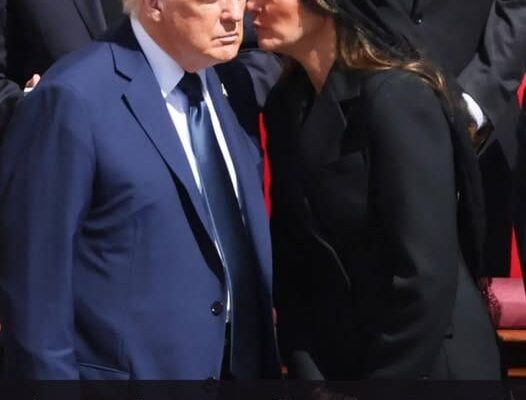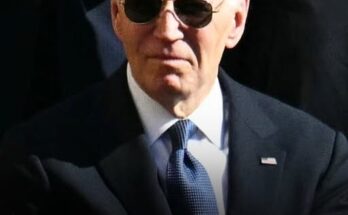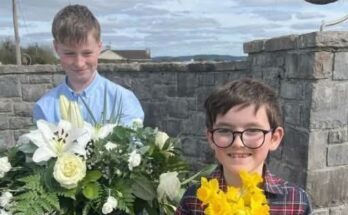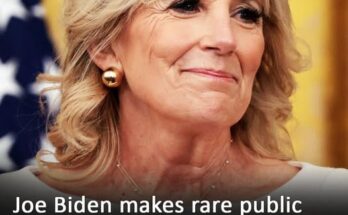Lip reader reveals seven-word exchange Donald Trump shared with Melania at Pope’s funeral

A fleeting moment of whispered conversation between former US President Donald Trump and his wife, Melania, at the historic funeral of Pope Francis in Vatican City today has sparked global intrigue. Lip-reading experts have claimed to have uncovered the private exchange, drawing international attention to the otherwise intimate words shared during this poignant ceremony.

World leaders, religious figures, and countless mourners converged at Saint Peter’s Basilica to pay their respects to the late pope. His passing on Easter Monday at the age of 88 triggered a wave of sorrow and reverence that echoed across the globe.

Among the dignitaries present was Ukrainian President Volodymyr Zelenskyy, who unexpectedly met with Donald Trump ahead of the ceremony. It marked their first in-person meeting since a heated disagreement over military aid and geopolitical strategy in February.
Their brief but amicable exchange added a layer of diplomatic significance to the ceremony, offering a striking contrast to the somber occasion. Against the backdrop of the ongoing war, the funeral became an unlikely setting for global dialogue, underscoring the complex intersection of personal encounters and international affairs.

Trump, dressed in a bold cobalt-blue suit that sharply contrasted with the sea of sombre black in the congregation, quickly became a point of attention as the two-hour ceremony unfolded. His distinctive attire and his positioning near the central altar did not go unnoticed.
Live broadcasts revealed that the Trumps were seated in a prime location, flanked by European heads of state and senior clerics. This placement came as a surprise to many, as earlier rumors had suggested they might be relegated to more distant seating due to protocol concerns.

Melania paid tribute to her devout faith and the Vatican’s dress code for women by donning a tailored black jacket, a knee-length pencil skirt, and a lace mantilla veil—an ensemble that adhered to the time-honored Catholic burial traditions.
Her graceful, modest attire evoked the elegance of past Catholic First Ladies like Jacqueline Kennedy. Meanwhile, her serene composure stood in striking contrast to her husband’s more dynamic presence, creating a subtle yet poignant visual balance at the ceremony.

As the congregation rose for a hymn midway through the service, cameras captured a moment when Trump leaned toward Melania and seemingly whispered a remark.
After analyzing the footage, forensic lip reader Nicola Hickling, with over 20 years of experience in high-profile cases, concluded that Trump quietly said, “I’ll go over and speak to him.”

The ambiguity of Trump’s statement—whether it referred to a religious leader, a political ally, or another guest—sparked immediate speculation. According to Hickling, Melania’s reaction—an almost imperceptible “side eye” followed by a neutral expression—hinted at a subtle disapproval or caution, a familiar dynamic for those who closely observe the couple’s public interactions.

Although the interaction was brief, it reignited discussions about the intricacies of their relationship, often analyzed through the lens of Melania’s composed demeanor and Trump’s propensity for impulsive remarks.
The Trumps’ participation in the ceremony also carried significant political and personal symbolism. Born in Slovenia and raised Lutheran before converting to Catholicism as a young woman, Melania has maintained a deeply personal and close relationship with her faith, adding another layer of meaning to their presence at such a momentous occasion.

Later, in a social media post, Melania described the experience as “humbling” after presenting Pope Francis with a set of rosary beads for blessing during their 2017 trip to the Vatican. Her role as a bridge between Trump’s administration and the Pope’s advocacy for marginalized communities was highlighted during the meeting, which also touched on issues like immigration and the welfare of children.
Trump, by contrast, has maintained a more transactional relationship with the Catholic Church. Despite his Presbyterian upbringing and later identification as a “non-denominational Christian,” he has proudly asserted that he won “by a lot” of Catholic votes in past elections, underscoring his political connection to the faith.

Ahead of the funeral, Trump framed his participation as a gesture of respect, stating in an interview with Fox News, “I just thought it was out of respect. It’s natural for me to be here because I received 56% of the Catholic vote.”
However, given Pope Francis’s vocal criticism of Trump’s policies on economic inequality, refugee rights, and climate change, political commentators were quick to highlight the irony of his visit. The contrast between their differing stances on these critical issues added an intriguing layer to the event.

The funeral itself was a blend of traditional customs and modern pageantry, featuring a procession of cardinals in crimson vestments, Gregorian chants echoing through the basilica’s towering ceilings, and eulogies that celebrated the Pope’s enduring legacy of compassion and commitment to world peace.
Notable guests included French President Emmanuel Macron, Canadian Prime Minister Justin Trudeau, and Brazilian President Luiz Inácio Lula da Silva, underscoring the pontiff’s global and cross-ideological appeal. Yet, amidst the solemnity, there were a few minor disputes that surfaced among the gathered dignitaries, adding a subtle tension to the otherwise reverent occasion.

The event served as a reminder of the intricate relationship between religion and statecraft, as diplomatic protocols dictated seating arrangements. Disagreements reportedly arose over the placements, which seemed to reflect underlying geopolitical alliances.
For Melania, the day carried a deeply personal significance. In contrast to her husband’s more theatrical presence, those close to her described the funeral as a moment of quiet spiritual reflection, marking a stark contrast to the public spectacle surrounding the occasion.

Her choice to wear the mantilla, a veil traditionally worn by Catholic women at papal audiences, reflected a deep respect for custom, while her poised demeanor echoed that of earlier First Ladies who skillfully balanced their private religious beliefs with their public duties.
Trump’s bold blue suit, reminiscent of his unconventional attire at past solemn events—such as the brown suit he wore during a 2014 press conference—provoked mixed reactions. While some criticized it as a breach of decorum, his supporters embraced it as a symbol of his “anti-establishment” stance, further reinforcing his distinctive public persona.

Though it was a minor moment amid the larger events of the day, the lip-reading incident underscored the constant scrutiny the Trumps are under. Hickling, an expert in her field, noted the challenges of her profession, emphasizing that accuracy in lip-reading depends heavily on camera angles, facial expressions, and contextual clues.
Her work, which has been used in court cases and high-profile celebrity scandals, serves as a reminder of the limitations of such interpretations. “Without audio, interpretations remain educated guesses,” she cautioned. However, her analysis aligned with patterns observed in Trump’s past behavior, particularly his tendency to engage in spontaneous conversations during official events.

As the ritual drew to a close with the somber tolling of bells and the final recitation over the Pope’s body, the Trumps, along with other mourners, quietly departed—marking yet another moment at the intersection of politics, religion, and global spectacle.
For Melania, the day could have offered a serene opportunity to reconnect with her spiritual roots. Yet for Trump, it appeared to be just another occasion to solidify his standing with a crucial voting constituency, adding a layer of political maneuvering to the solemn proceedings.

Amidst the rumors and the spectacle, the burial stood as a testament to Pope Francis’s enduring influence—a leader who, even in his final days, managed to bring together divisive figures in a rare, communal space for reflection and introspection. His legacy of unity and spiritual guidance resonated deeply, transcending politics and personal differences.




